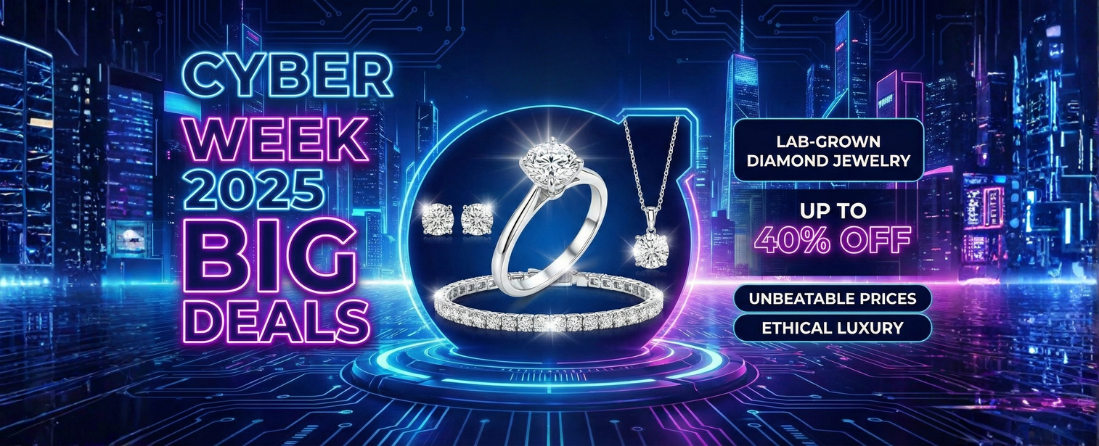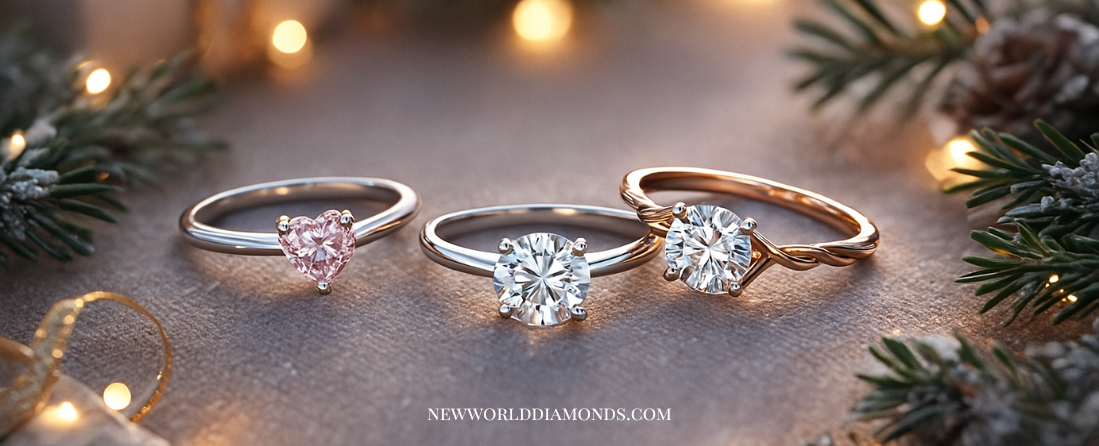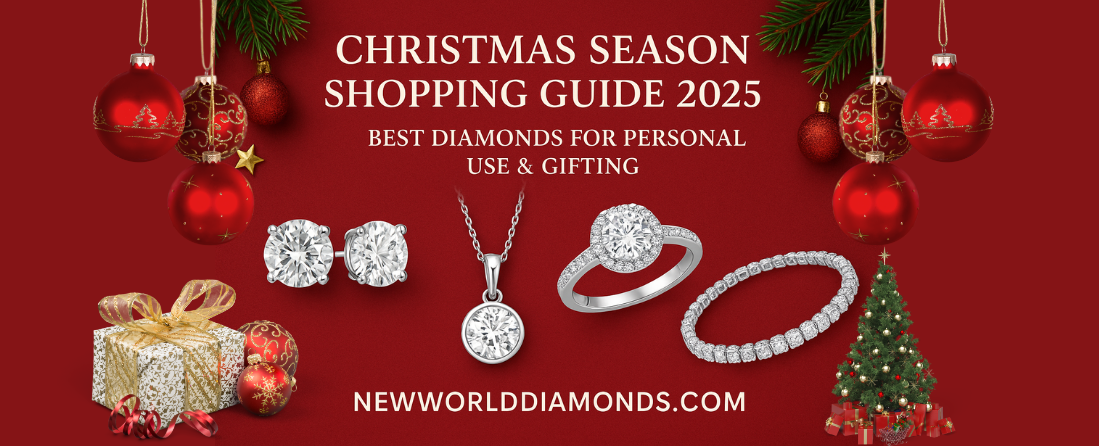Contact Us
Contact Us
The ideal gem to complement your jewelry
Browse our unique collection
SHOP LAB GROWN DIAMONDSDiamonds Grown in Lab
Color is a natural element in diamonds. As the gems grow under the earth over millions of years, trace elements can cause a yellowish or brownish tint. (We know what you’re thinking, and no, diamonds aren’t formed from coal. They are actually made from carbon deposits.) It’s more common for diamonds to have some of this tinting — which varies in hue, tone, and saturation — than to be absolutely colorless.
Color or the absence of any in a diamond determines its fortune. This lack of hue in a diamond represents its chemical purity and structural perfection. A gemstone-quality diamond is evaluated for the sheer absence of any color and demands higher value. Diamonds come in a fascinating array of colors ranging from highly desirable blues, yellow, pink, green, red, and even black. Nevertheless, when a white diamond is considered, the presence of the slightest yellow tint mars its value and drastically reduces the price. Lesser body color means a better reflection of true color in a white diamond, resulting in a greater value.
Diamonds By Shape










The traditional “clear” stones found in most engagement and wedding rings are known as known as white diamonds. Whereas fancy colored diamonds are the vivid shades like pink, green and yellow. The GIA (Gemological Institute of America) has standardized diamond color grading on a D-to-Z scale. Similarly to IGI (International Gemological Institute), who also uses a D-to-Z scale but for lab grown diamonds. All diamonds on this letter scale are considered “white,” although on the lower end they can have a tinge of yellow.
Here’s some irony for you: Diamond color, in terms of grading, is determined by the lack of color in a diamond. The less color a diamond has, the higher the color grade. Diamond color subtly distracts the eye from seeing sparkle, so colorless diamonds will appear to sparkle more than yellowish or brownish tinted diamonds. Below you’ll find the most widely accepted industry diamond color grading chart.

Diamond color is graded by evaluating the body color of the diamond on a pure white background, face down. Gemologists will compare the diamond to master stones, or a GIA-verified set of cubic zirconia, with grade color shading. If the diamond has more yellow than one but less than the other, it will receive a grade in that range. (For example: More yellow than F, but less than G, would be a G color diamond. You might also hear these referred to as “G+ color diamonds” to indicate that they’re at the top of this specific color range, or whiter than other stones in the same color grade.)

Lab grown diamonds are environment-friendly and sustainable selection of diamonds that don’t support mining malpractices.

Lab crafted diamonds and naturally occurring diamond have the exact same physical, chemical, and optical properties.

Lab manufactured diamonds offering you a more affordable price for high-quality and size than natural diamonds.
In the letter-grade diamond color scale, D (colorless) is the highest and best grade, and Z is the lowest. Diamond used to be graded like gemstones on a range that included AAA, AA, A, and B, so the new scale started at D to avoid confusion. This color chart shows how the color of a diamond changes visually across the scale. Which diamond color is best? That depends on what you’re looking for.

Diamonds in this range have no color or very minute traces of color, that can only be identified by trained gemologists. They typically need to be compared to higher or lower-graded diamonds to accurately identify the color. Fewer than 1% of all gem-quality diamonds fall in this range.

Diamonds in this range have minor traces of color that may be identified by trained eyes. The G/H color diamonds are most popular because they balance value and lack of color. Minor sparkle distractions can be noticed in I/J colors, however, these diamonds still sparkle very brilliantly and have great value, when balancing the other C’s. The near-colorless range represents the top 15% of all gem-quality diamonds.

Diamonds in this range tend to have a faintly yellow or brown tinge. The color affects the diamond’s sparkle by very slightly dulling it. When examined, the color may be recognized in jewelry, although there are ways to minimize this. These diamonds represent the top 40% of all gem-quality diamonds.

Like every other brand, we believe that the setting for the diamond ring plays a vital role in determining the final look. Buyers these days prefer unique designs for their chosen gems. Here are some Engagement Ring Settings that you will love, ranging from plain to various diamond-accented styles that will blow your mind.
Sweet Caroline: Though seemingly plain, this design is a beauty in itself and an excellent choice for those who love the classics.
Make way for Isabelle: The setting features a Pave design to enhance the band’s look.
Let Celia add that twist: If you love surprises, this setting, which has twist patterns on both sides of the frame, is an excellent fit for your personality!
Unconventional Janessa: Wish for something different on your big day?! The setting features a crossing pattern design, which is like with tiny diamonds.
Splitting like Catherine: Featuring a square diamond halo supported by split shanks on both sides, this is great for the ones who love a little extra excitement in their lives.
Despite how different Lab Grown Diamonds are from the natural ones when it comes to origins, the same certification standards apply to them, as the 4 C,s (cut, clarity, color, and carat) determine the suitability of all diamonds. As Lab Grown Diamonds are crafted to perfection and have the same carbon content, they will go through similar grading processes.
The new generation is trying to minimize and end environmental pollution in their way! Diamond Jewelers have chosen Lab Grown Diamonds to avoid contributing to the waste of natural resources. A sustainably rated Lab diamond is the one that experts create without endangering the atmosphere and any life form in sight.
Lab Grown Diamonds come in all kinds of brilliant colors. The collection will live up to your expectations and has the best to offer in terms of quality and shade. Here are some of the most preferred tinges.
White: Everyone’s staple preference for engagement ceremonies and proposals, these magnificent Lab Grown Diamonds are better than their natural counterparts, as they sparkle like the stars in the sky!
Blue: These gems have gained popularity in recent years and have a regal air about them, making them perfect for any festive occasion.
Pink: Though not the most preferred, this is still a popular hue for those who want something unique but don’t wish to go all out. The color speaks of sophistication and a charming attitude and is perfect if you want a Pink Diamond Ring.
Smokey: It is almost similar to the white diamonds, but the transparent texture sets it apart. People who don’t want the brightness of white diamonds go for it.
Diamonds By Color













Cyber Week 2025 at New World Diamonds is the ideal time to buy lab-grown diamond jewelry at discounted prices. From solitaire rings to stud earrings and bracelets, get premium quality gems at holiday sale rates — perfect for gifting or treating yourself.

Planning a magical Christmas 2025 proposal? This guide helps you pick the perfect lab-grown diamond ring from New World Diamonds — with real examples of rings, tips on shape and setting, and why lab-grown diamonds are the perfect choice for a holiday proposal.

This Christmas, New World Diamonds is offering special Sale Day discounts on solitaire rings. From classic round solitaires to rose-gold settings, explore the best values on engagement-ready pieces. Learn which solitaire rings are on sale, their features, and why now is a great time to buy.

Celebrate Christmas with sustainable lab-grown diamonds. From studs and pendants to rings and bracelets, discover the best jewelry pieces for gifting and personal use at NewWorldDiamonds.com.